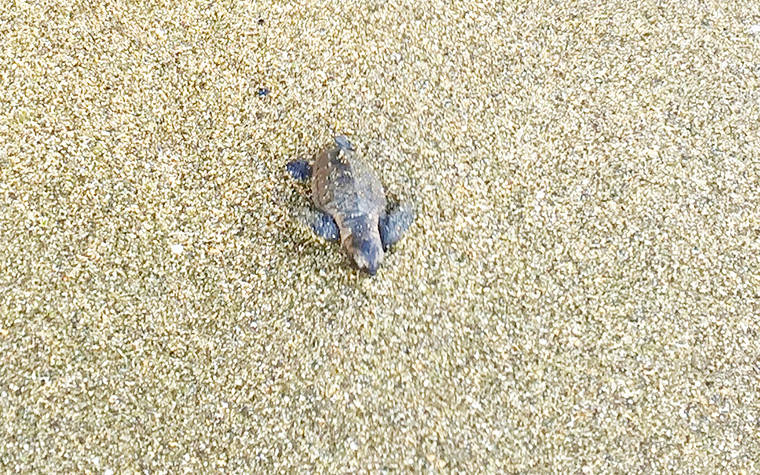Hawksbill Turtle Population Graph | All given categories of turtles population increased with marginal drop still 1984. The hawksbill turtle gets its common name from the shape of its curved, pointed beak, which resembles that of a bird of prey. Nests and offspring are at risk for being attacked by dogs, raccoons, rats, crabs or seagulls. It since there is no exact population stat on the hawksbill turtle we used the population of the year 2004 and decreased it by 4% each year. Nearly 40 years ago, troubled by the effects of trade and the loss of nesting.
The hawksbill sea turtle (eretmochelys imbricata) is a critically endangered sea turtle belonging to the family cheloniidae. The hawksbill turtle is an omnivore. Hawksbill turtles are mainly carnivorous and use their narrow beaks to extract invertebrate prey from crevices on the reef. The hawksbill sea turtle (eretmochelys imbricata) is a critically endangered sea turtle belonging to the family cheloniidae. The species has a worldwide distribution, with atlantic and pacific subspecies.

Like several other sea turtle species, the hawksbill is capable of migrating long distances between nesting beaches and foraging areas. Population structure of hawksbill turtles on a foraging gound in the dominican republic, chelonian conserv biol. Marine turtles fulfill important roles in marine ecosystems hawksbill turtles also feed on invertebrates, with a predilection for sponges. The species has a worldwide distribution, with atlantic and pacific subspecies. Hunted intensely for their beautiful shells since ancient times, hawksbill populations declined dramatically during the 20th century. Hawksbill shells slightly change colors, depending on water temperature. A further distinctive feature is a pair of claws like other sea turtles, hawksbills make incredible migrations in order to move from feeding sites to nesting grounds, normally on tropical beaches. Approximately 2,000 hawksbills nest annually on the. It is the only extant species in the genus eretmochelys. Population structure of hawksbill turtles on a foraging ground in the dominican republic. Young hawksbill turtles are unable to dive deep and so spend their early lives floating amongst sea plants near the water's surface. Current estimates include 8,000 to 10,000. A hawksbill turtle on a reef © nicolas pilcher.
Learn more about their diet, life cycle, and threats. Their characteristics, habitat, food, breeding pattern, threats, conservation efforts and other information have been discussed here. The hawksbill turtle is an omnivore. The hawksbill turtle (eretmochelys imbricata) is one of the seven species of marine turtles and one of six in the family cheloniidae. They have two pairs of prefrontal scales on the top of the head.

When they are young, it is heart shaped but that will change as they get older and the shell becomes longer. The hawksbill sea turtle (eretmochelys imbricata) is a critically endangered sea turtle belonging to the family cheloniidae. But none of the above affects the hawksbill turtle population more. A hawksbill turtle on a reef © nicolas pilcher. The hawksbill turtle's tapered head ends in a sharp point resembling a bird's beak , hence its name. Current estimates include 8,000 to 10,000. They have two pairs of prefrontal scales on the top of the head. The hawksbill turtle is an omnivore. The hawksbill sea turtle (eretmochelys imbricata) is a critically endangered sea turtle belonging to the family cheloniidae. For example, there is a small population of hawksbill turtles in the united states (specifically in puerto rico and the u.s virgin islands), where about 500 to 1,000 hawksbill nests are laid every year. Hawksbill turtles are mainly carnivorous and use their narrow beaks to extract invertebrate prey from crevices on the reef. Hatchling hawksbill illustration © dawn witherington. Nests and offspring are at risk for being attacked by dogs, raccoons, rats, crabs or seagulls.
The hawksbill turtle's tapered head ends in a sharp point resembling a bird's beak , hence its name. Learn more about their diet, life cycle, and threats. Hawksbill turtle populations, while scarce, are actually scattered throughout the world. The hawksbill turtle (eretmochelys imbricata) is one of the seven species of marine turtles and one of six in the family cheloniidae. The hawksbill turtle is a critically endangered species and faces numerous threats such as tortoise shell public awareness.
Unlike the other sea turtle species the hawksbill sea turtle is considered to have a tough stomach because they can eat sponges which are toxic lowest population: Status of the hawksbill turtle (eretmochelys imbricata) in the caribbean region. When they are young, it is heart shaped but that will change as they get older and the shell becomes longer. A hawksbill turtle on a reef © nicolas pilcher. Marine turtles fulfill important roles in marine ecosystems hawksbill turtles also feed on invertebrates, with a predilection for sponges. Only a handful nest in. Scientists are focusing their research on the hawaiian hawksbill sea turtle in an effort to bring back the endangered population and are making some. Stage 1 includes eggs and hatchlings (<4 cm ccl, curved carapace length); Learn more about their diet, life cycle, and threats. Learn about hawksbill turtle, as well as the threats this species faces, what wwf is doing to protect its future, and how you can help. It is the only extant species in the genus eretmochelys. Hunted intensely for their beautiful shells since ancient times, hawksbill populations declined dramatically during the 20th century. We're working with a number of.
For example, there is a small population of hawksbill turtles in the united states (specifically in puerto rico and the us virgin islands), where about 500 to 1,000 hawksbill nests are laid every year hawksbill turtle population. Only a handful nest in.
Hawksbill Turtle Population Graph: Unsurprisingly, the hawksbill turtle is named for its narrow, pointed beak, which resembles a bird of prey.
comment 0 Post a Comment
more_vert